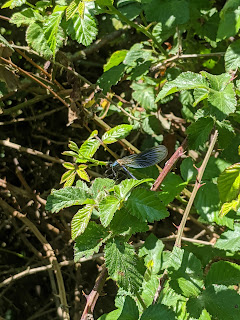I hauled out the moth trap for another go at seeing some of our nocturnal nature. Sadly once again the weather changed quite dramatically overnight so the catch was very small.
What wasn't small was the Privet hawk-moth I found within. These stunning moths are the UK's largest breeding species with a wingspan of 9-12cm and are brightly marked with a red and black abdomen and pink and black striped underwings.
 |
| Privet hawk-moth |
 |
| Wings fully open |
 |
| Look at that eye |
Also of note was a White ermine moth which possesses one of the fluffiest heads you're ever likely to see. The name arises from its similar appearance to the ermine robes worn by royalty.
 |
| White ermine moth |
 |
| Details of the feathered antenna |
A Common emerald moth provided another splash of colour...
 |
| Common emerald |
...while the Clouded border is always nice to see.
 |
| Clouded border |
When running a moth trap it is necessary to get up just before daybreak to pot up any moths that haven't made it into the trap but have settled nearby otherwise the local birds soon learn about the fly-through takeaway on their doorstep. So I was up at 3.30am and, having saved many lives from hungry beaks, took a walk to the castle as the day unfolded around me. Beautiful pastel colours lit the sky as the sun slowly made its way up, while several Skylarks sung from on high and a ghostly Barn owl slowly quartered fields near the castle, and a Weasel broke cover to reveal himself fleetingly.
 |
| 3.50am heading to the castle |








































